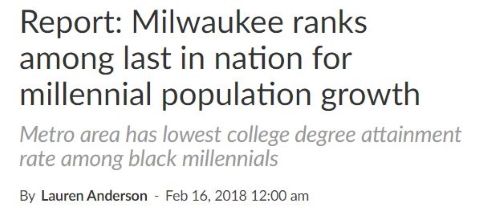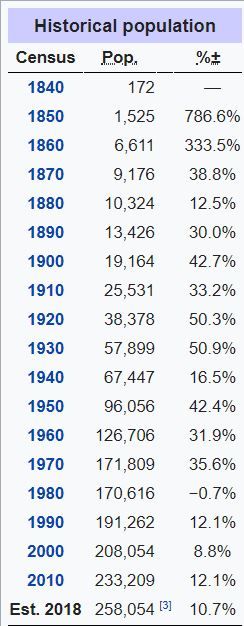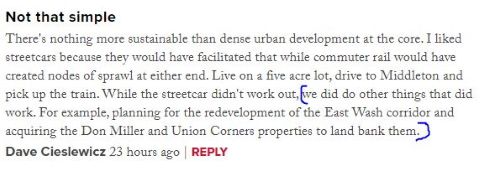His argument is that Madison is green with envy because Milwaukee has a public market and a streetcar. Further, these aren't just nice amenities, they are development tools. Add these things and you get real estate investors building new buildings and gussying up old ones to be repurposed. And, when you do that, Millennials will come flocking to your city like a junkie to the needle.
Where to start?
Let's begin with a quote from the article:
One of the things that is little understood about fixed rail systems, like streetcars, is that they aren’t just about transportation. They are a very visible and permanent public amenity that sparks other development.
Permanent? Ask the folks in the Santa Clara Valley just how permanent rail is. One of their light rail route will cease to operate a few days after Christmas and be replaced by bus.
The Almaden Spur Light Rail, Route 900, will no longer operate, beginning 12/28 when VTA's new transit service starts.
Almaden Spur Light Rail is being replaced by Bus Route 64A.
Also note that Cieslewicz affirmatively states that streetcars "spark other development". Is this true? Cieslewicz himself doesn't seem to know as he states in the very next paragraph:
…since the streetcar was approved, new development along the line includes 435 new apartments, 660 new hotel rooms and a 28 percent growth in property values, not to mention numerous restaurants and bars that cannot be directly attributed to the streetcar but might well not have happened without it.
So...maybe. And maybe is the conclusion of the research done into whether streetcars spur development.
The literature regarding empirical measurement of actual changes in economic activity, such as changes in retail sales, visitors, or job growth, is almost nonexistent for streetcars.
So Cieslewicz categorically states that streetcars spark development and then proceeds to admit that development along Milwaukee's streetcar route may not be the result of the streetcar. In an op-ed weighing in against the streetcar up at Urban Milwaukee, Samuel Jensen, director of the Milwaukee Transit Riders Union, addressed this issue. He wrote:
What the data does point to, however, is that streetcars tend to concentrate development that would have occurred anyway along specific corridors. If Milwaukee’s streetcar was planned to run through blighted, underdeveloped, or impoverished areas of the city (for example, a route to spread development from the east side to the west side of downtown) then that might be good enough. When the route is planned to go through some of the wealthiest and most rapidly developing areas of the city, though, it just amounts to an investment that further centralizes wealth in a city already grappling with appalling levels of segregation and inequality.
In my opinion, it boils down to how our former mayor view public transportation more generally. It really seems like he views it primarily as a development tool whereas I would offer that it is an urban mobility tool. I would have loved it if, during his 8 years as mayor, he would have given a fraction of the political capital, blood, sweat, and tears to improving Metro Transit as he did to getting a 15-storey addition to a luxury hotel built that ran afoul of the building guidelines of the historic district that it now stands in. I recall his major contribution to bus service in Madison being a fare increase.
This is nothing new. Cieslewicz drank long and deep of the Richard Florida kool aid many years ago and this article seems to be a justification for his rejected policies/mindset. When your lens is that of your city being "in the race for coolness", it's no wonder that your teleological premise is that public transit is primarily a development tool, something that should be "hip" as opposed to a tool that gives people the freedom to go where they need to go when they need to go. As urban planner Christof Spieler noted in his book Trains, Buses, People – An Opinionated Atlas of U.S. Transit about the Milwaukee streetcar, "…it will do nothing to speed up the trips of current transit riders or link Milwaukee residents to suburban jobs."
Cieslewicz quotes one Bob Monnat, the COO of a company that is a large real estate developer in Milwaukee as saying, "We're trying to attract the millennial population." As mayor, this was one of Cieslewicz's prime fixations with his logic being that millennials will move to your city if you have cool stuff like public markets and streetcars. (And bike lanes too.) So how is that working out for Milwaukee?
From the Milwaukee Biz Times:

Let's contrast that to Madison. From the Milwaukee Business Journal based on a Brookings Institution study:

A study by the National Association of Realtors, as detailed in this Bloomberg article, shows that Madison is the 2nd most popular destination for Millennials who are relocating. And that is the case despite not having a public market nor a streetcar.
“In comparison to other areas, Madison offers one of the highest wages for millennials,” Lawrence Yun, NAR’s chief economist, said in a statement. “This income level combined with the robust employment opportunities and the affordability, make Madison among one of the most appealing locations for millennials who are looking to stay longer and raise families.”
Jobs and affordability. Jobs and affordability. Jobs and affordability. Jobs and affordability. NOT public markets, and streetcars, and other amenities. Cieslewicz writes that "Milwaukee offers much more diversity across a much broader spectrum" of cultural offerings. True enough. But they aren't attracting the vaunted Millennial cohort nor enough of any other group. Here's is Milwaukee's historic population:

Now here's Madison's:

Things may be even worse for Milwaukee than the above graphic betrays. The city's population went up during the first half of this decade so that the estimate in 2014 was above 600,000. But it has lost about 2,000 people a year since 2015. (See here.) Do keep in mind these are population estimates and that we'll have to wait for next year's census to get the real story. Still, these numbers don't bode well for our state's largest city.
Earlier this month the Wisconsin Policy Forum released a report which showed that Madison's tech sector was "booming". Milwaukee's? Not so much.
The latest Quarterly Census of Employment and Wages from the Bureau of Labor Statistics shows that Dane County (wherein lies Madison) is generating more private sector jobs than the rest of the state, including Milwaukee, combined. And we're doing it without streetcars and public markets.
And there is no shortage of real estate development in Madison. Just take a gander at this article chronicling the transformation of the Capitol East District. All done without streetcars and public markets. Instead one of the primary impetuses was land banking done by the city and Cieslewicz admits this in a comment on his article.

The sad part is that, when he was "Mayor Dave", Cieslewicz oversaw great growth in Madison – done without his streetcar plan coming to fruition and the public market still a dream. He knows a city can prosper without having all of the "hip" amenities. And so it is farcical to suggest that we in Madison should be envious of Milwaukee's "development tools" when we are growing in population while the Cream City is not; while we are attracting more Millennials, and creating more jobs.
A couple final thoughts.
First, I want to say I am in agreement with Haven McClure who left a comment on the article. Do read it. In it they argue that Cieslewicz's preoccupation with streetcars, public markets, and the race to be cool did not help in the push for sustainability. Further that his desire to make downtown/isthmus living ever more luxurious was to ignore Madison's southwest side with its increasing struggles with poverty, violence, etc. You can read the author's reply in the screenshot above. It is striking to me that his reply stuck to urban development at the core and completely ignored the argument that such an approach does little to help the most disadvantaged. Cieslewicz certainly does seem be a trickle-down economics adherent. Is the economic success of the Third Ward, Bayview, or Walker's Point helping alleviate the poverty on the largely black north side in Milwaukee, one of America's most segregated cities? You can see the same in Chicago where things are going very well in The Loop and North Shore but that success hasn't trickled down to poorer communities. (See here.)
Lastly, Cieslewicz admonishes his readers against dismissing Milwaukee. ("And yet to dismiss Milwaukee is to cheat ourselves.") This is a straw man, it seems to me. He wrote this after having posited that "Madison and Milwaukee might despise each other, if they bothered to think about the other place at all." He begins his article this way which helps explain why it seems to be so silly to me.
Perhaps the situation has changed but it wasn't long ago that Milwaukee County was the biggest provider of in-migration to the Madison area. People from Milwaukee come here to Madison to see UW Badger games while Madisonians travel to Milwaukee to catch the Brewers and Bucks in action. Amtrak even ran football specials between Milwaukee and Madison until 1976. Speaking of Amtrak, I would not hesitate to say that a lot of people in both cities thought quite a bit about each other when plans to extend Amtrak's Hiawatha line to our fair burg were announced. Cieslewicz just wrote about this a few days ago in a piece about the fine Wisconsin Public Radio podcast Derailed which chronicled the demise of the planned extension. Badger Bus, which provides rides between Madison and Milwaukee, now has 8 trips from either city every day of the week. Madison and Milwaukee are solidly Democratic and are routinely demonized by many rural residents in Wisconsin and their Republican representatives.
We think about each other a lot and I see signs that the old rivalry between these two cities is slowly going away. Check out this podcast from Tone Madisonwhere Milwaukeeans and Madisonians discuss the views we have of one another through and arts & culture lens.
But we need to act. Since Milwaukee wants to be the freshwater research capital of the world, we here in Madison should help. We need more things like the Freshwater Collaborative and less like Cieslewicz's article.
I did find at least one point of agreement with his article, though. He ended his piece by writing "We can learn from each other" and I am complete agreement with that.